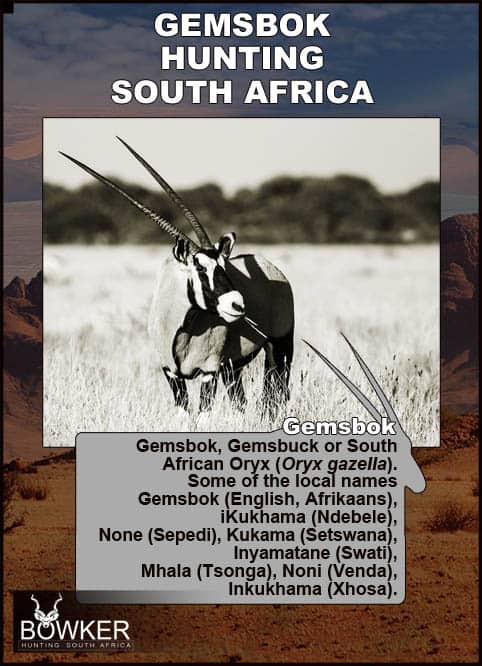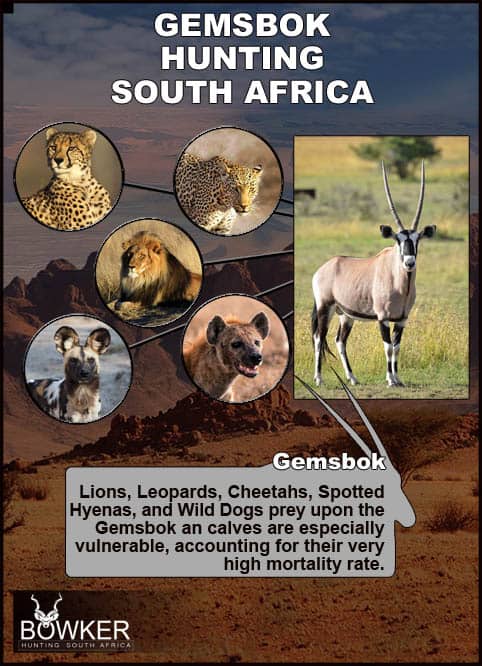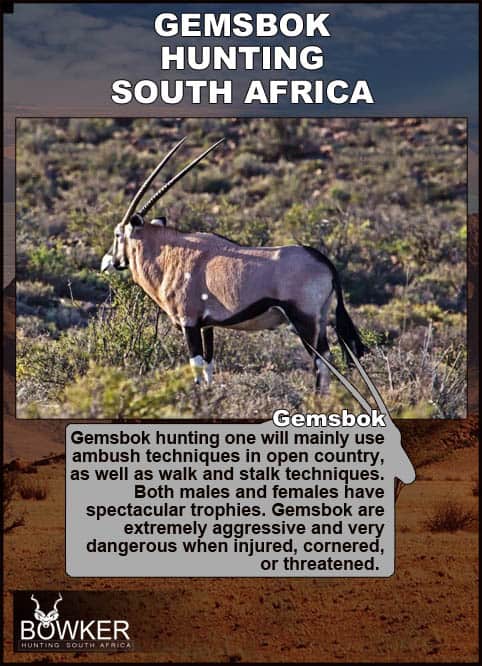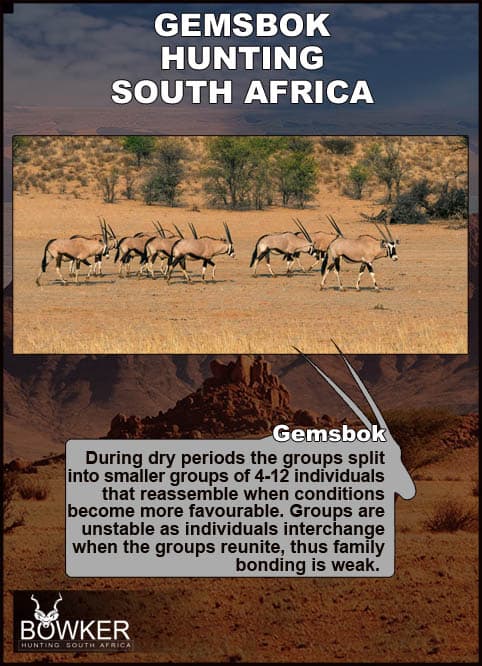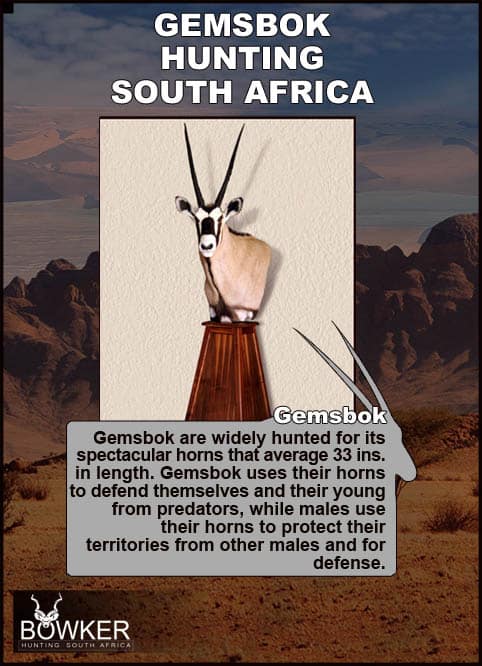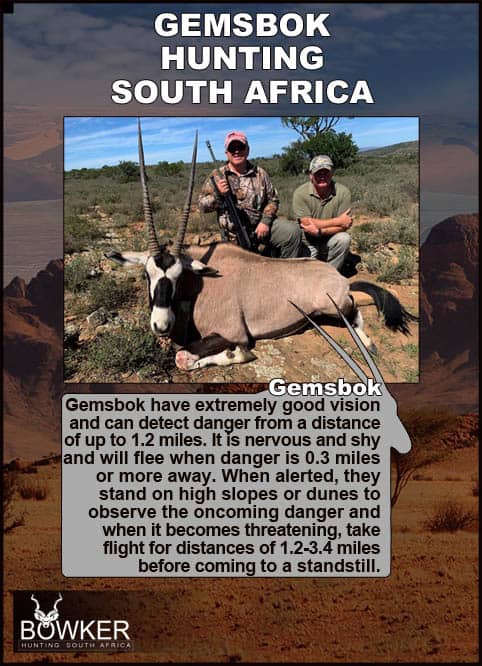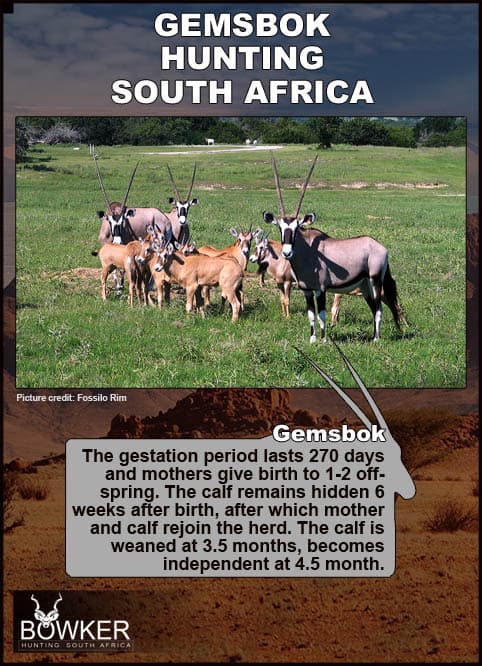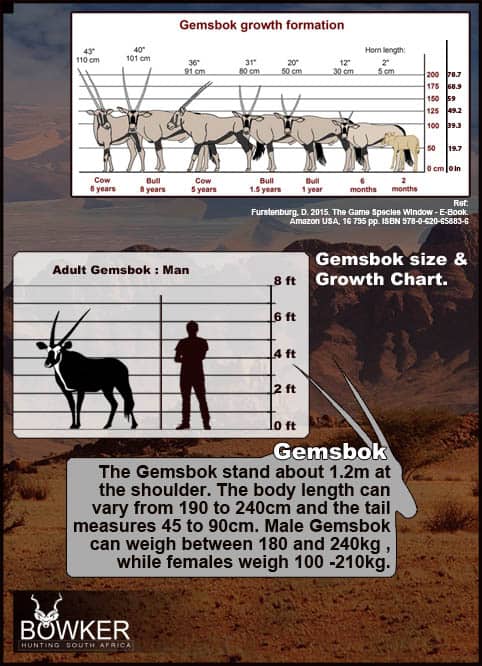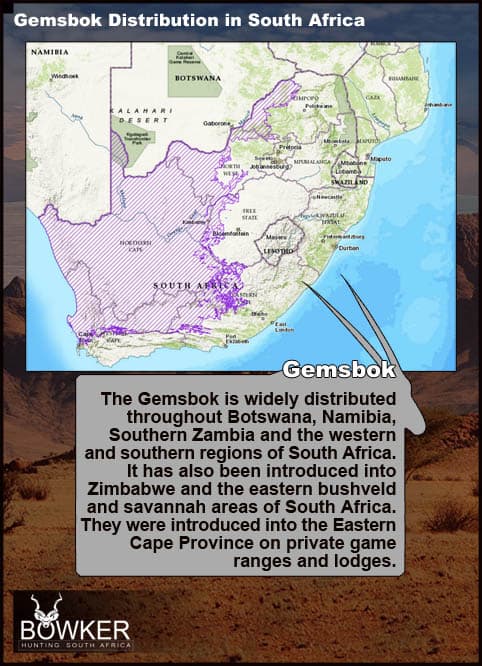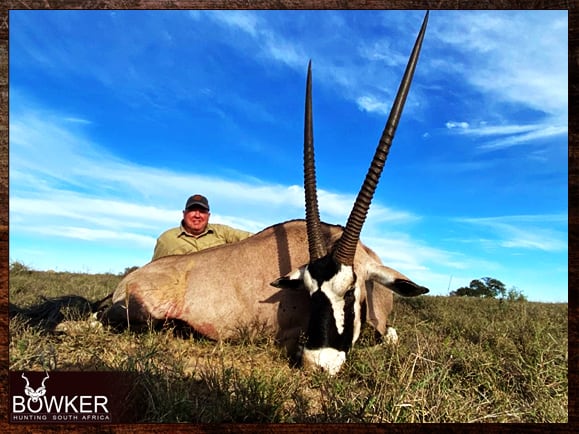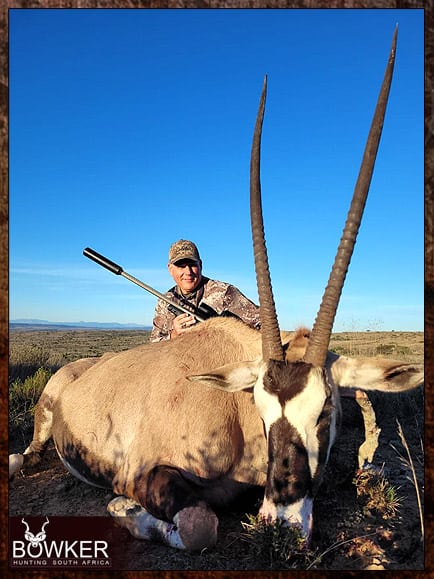
Summary
Gemsbok or Oryx Trophy Hunting is available in South Africa.
Both males and females carry long spear-like horns, are aggressive, and are very dangerous when injured or threatened.
There are no seasonal restrictions on Gemsbok in Eastern Cape, South Africa. Nick Bowker Hunting hunts gemsbok trophy hunts year-round.
The Gemsbok is indigenous to South Africa and Nambia. Males and females make spectacular trophies.
Hunt these animals using ambush techniques in open country and spot and stalk techniques.
The Gemsbuck in English, or Gemsbok antelope in the local language, is a trophy all first-time hunters to Africa should consider.
We offer a popular Gemsbok Kudu package with over 30 plains game animals available for hunts in our various packages.
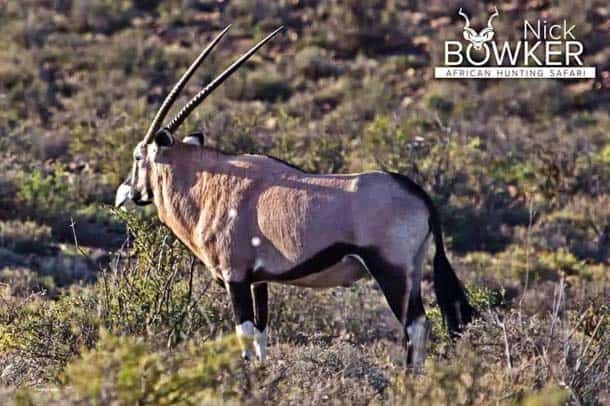
Table of Contents
Gemsbok (Oryx) Trophy Fees in South Africa for 2025
The average price of a Gemsbok is $1500. African safari hunting packages often include a Gemsbok Trophy.
Our Gemsbok price is $1500 for 2025.
All-Inclusive $4500 Starter Plains Game Package for seven trophies and eight days hunting. (Inclusive of an Oryx Trophy)
- Gemsbok
- Black Wildebeest
- Springbok
- Impala
- Blesbok
- Warthog
- Mountain Reedbuck
Included in the Trophy Gemsbok hunt package is a licensed hunting guide. As well as a hunting license and all permits.

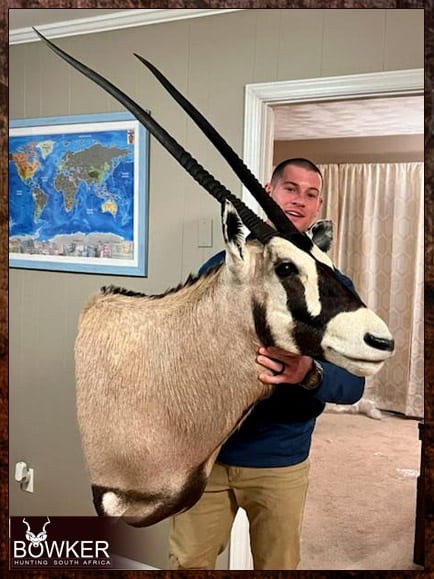
Gemsbok Hunting in South Africa

Shot placement must be in the bottom third of the animal directly above the front shoulder. This will ensure a heart or lung shot. Avoid head and neck shots, which are high-risk.
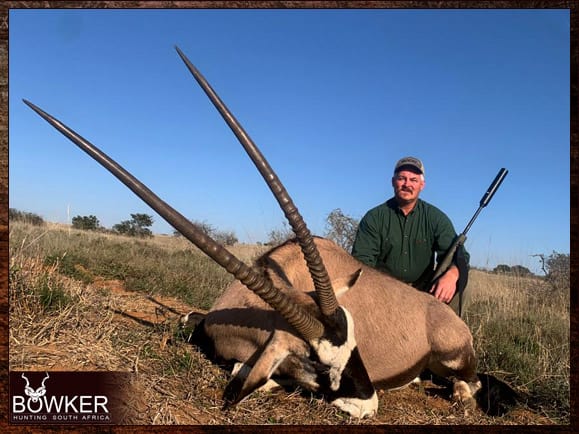
Your Gemsbok trophy should have an average shoulder height of around 46 inches, weigh about 500 pounds, and have a Horn length of approximately 36 and 38 inches. A record class is Gemsbok, which is over 40 inches.
The minimum score under Safari Club International for Gemsbok is 81. Add the length of each horn and the circumference of the bases to get your SCI score for your Gemsbok trophy.
Males and females make spectacular trophies. Both sexes carry long spear-like horns. Gemsbok can be highly aggressive and dangerous when injured or threatened.
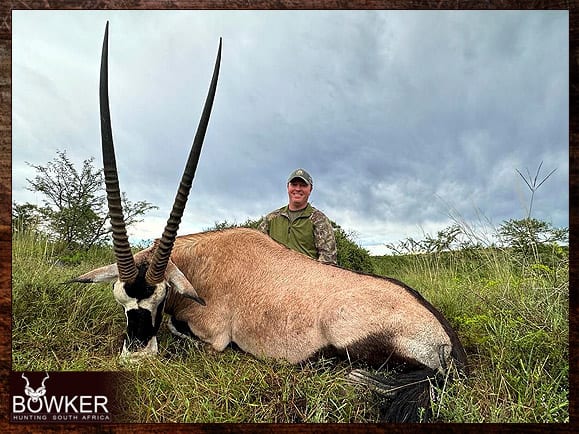
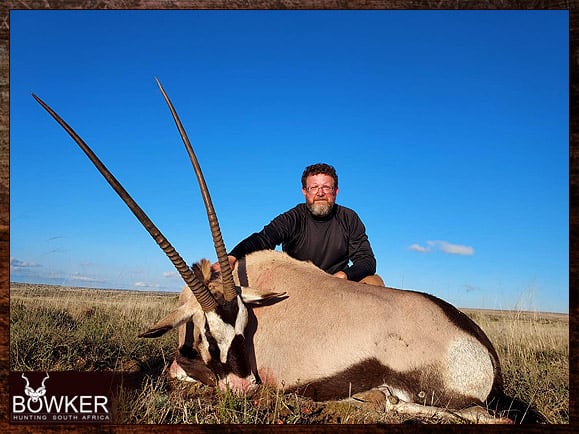
Gemsbok Oryx has been introduced into the Eastern Cape and is not genuinely free-ranging. We have an outstanding herd available on the Hopewell hunting ranch.
Standard cattle and sheep fences are a partial impediment to the movement of a gemsbok.
Warthog holes provide the ideal escape plan for the Gemsbok. They flatten their horns and go through the warthog hole.
Gemsbuck hunting is standard across the Eastern Cape. Hunt Gemsbok using ambush techniques in the open country and spot and stalk techniques.
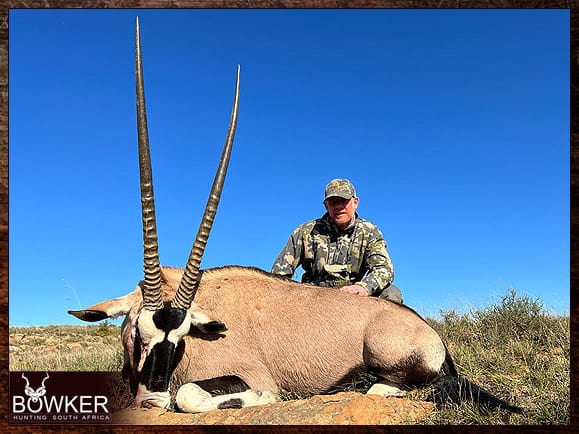
Trophy Judgement and Rifle Caliber for Hunting
Rifle Calibre for Gemsbok Antelope Hunts
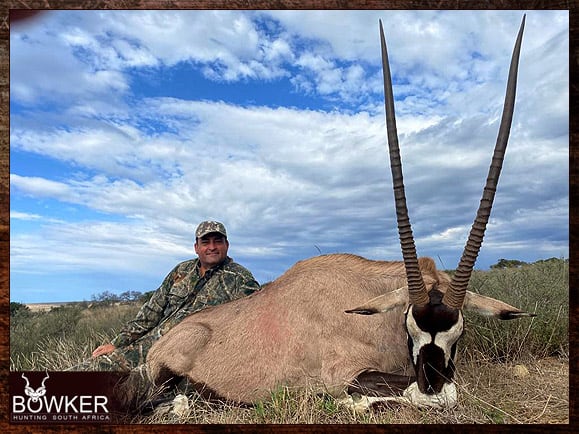
This open country will demand one of the flat shooting rifle calibers and scope combinations. Gemsbok is alert with excellent eyesight, hearing, and smell; your stalk needs to be carefully planned and executed.
For those hunters who wish to avoid going through the red tape of bringing a rifle into South Africa, Nick Bowker Hunting has 300 Winchester Magnums fitted with suppressors.
Mounted on the rifles are high-end Swarovski optics. We have hand-loaded Hornady ELD-X 200-grain ammunition. The rifles, including shells, are free of charge as part of all hunting packages.
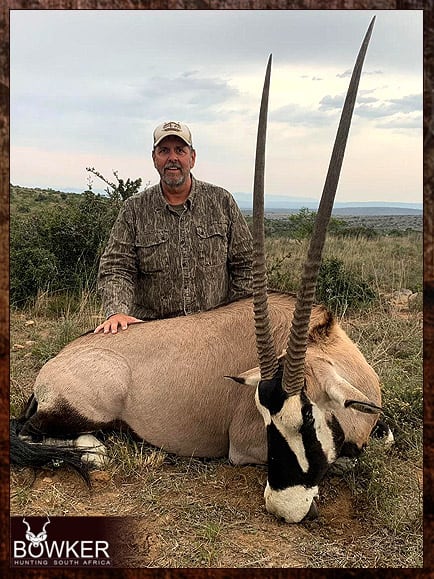
Trophy Judgement for Hunting Gemsbok
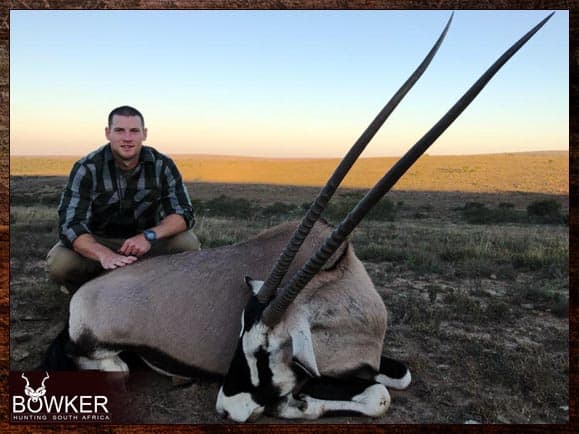
The humped shoulder can result in a high shot. Therefore, follow the front leg’s backline to about one-third into the body.
Never shoot above the horizontal midline of this beautiful antelope unless you require a good hike.
Remember that the cow’s horns tend to be long and often out-score the bull when assessing the trophy. Remember that the body size differs remarkably from one Gemsbok to another.
A Gemsbok hunt will provide a fabulous trophy; its meat is one of the most delicious on the African continent.
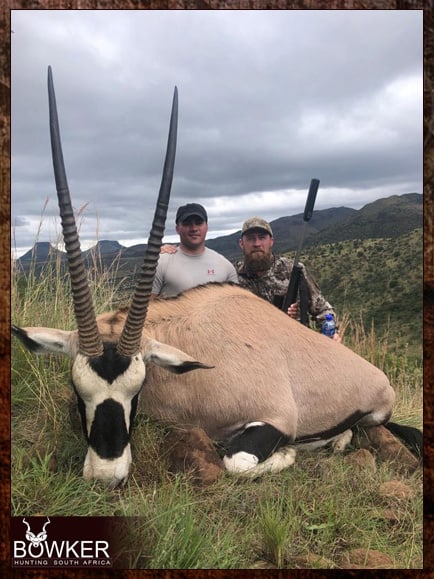
Difference Between Male and Female
Males and females present very low sexual dimorphism (physical differences between males and females) and are almost identical in appearance.
This is most notable because both males and females have horns, though the males are shorter and thicker. In contrast, female horns are longer and thinner and tend to curve backward.
Gemsbok has evolved this reduced sexual dimorphism to facilitate more extended acceptance of juvenile males by the older territorial males.
As a result, this has allowed the Gemsbok to survive better in vast empty spaces where finding mates can be a severe challenge. In contrast, the nyala, for example, exhibits very high sexual dimorphism.


Interesting Facts About Gemsbok for Hunts
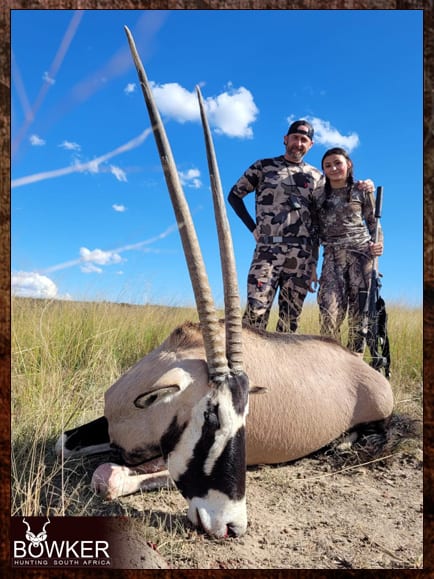
- The straight, rapier-like horns are used in territorial combat and as lethal weapons against predators.
- Moreover, they can kill lions.
- Gemsbok minimizes water loss through sweat by increasing their body temperature to an astonishing 45°C and dissipating the stored heat at night.
- Consequently, overheating is averted by a filigree of blood vessels in the nose, known as the carotid, through which all the blood that passes to the brain is circulated and cooled.
- Hunting Gemsbok can be undertaken in the Texas hill country as well as other US states, but it is indigenous to Africa.
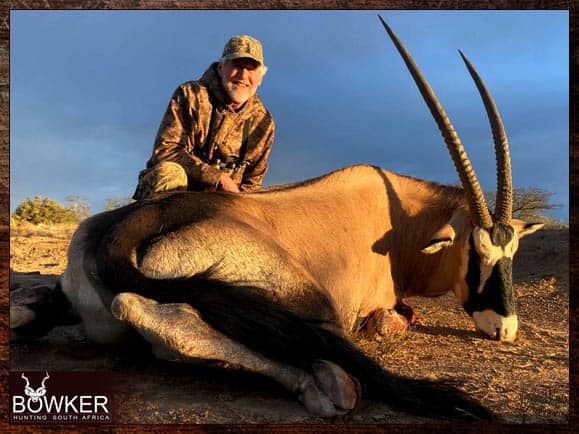
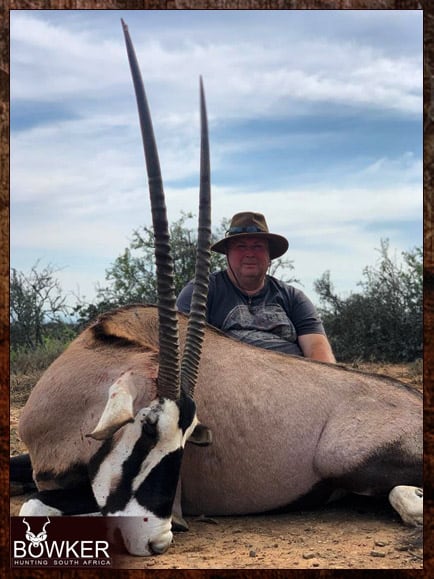
- A slow metabolism allows these antelopes to survive the year without drinking in the Kalahari desert.
- They get the moisture they need from their food, for example, the desert melons that they dig up in drought times.
- After giving birth, a female hides her calf for three to six weeks, remaining nearby and visiting a few times a day to nurse.
- The calf’s pale brown lighter colors works as camouflage.
- Oryx hunting in Southern Africa’s arid regions was conducted by bow and arrow and was an important food source. Gemsbok is hunted safari style in Africa.
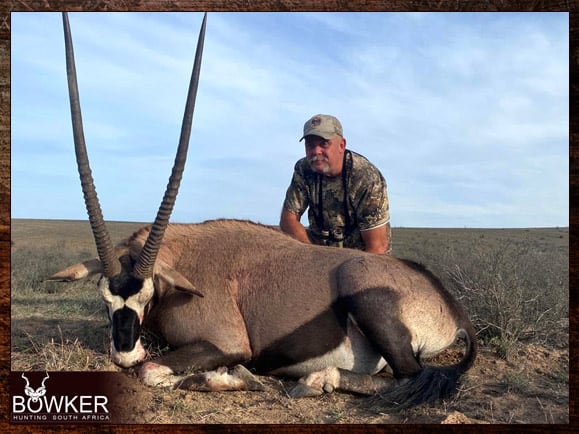
About the Gemsbok for Hunters
Description of the Gemsbok Species
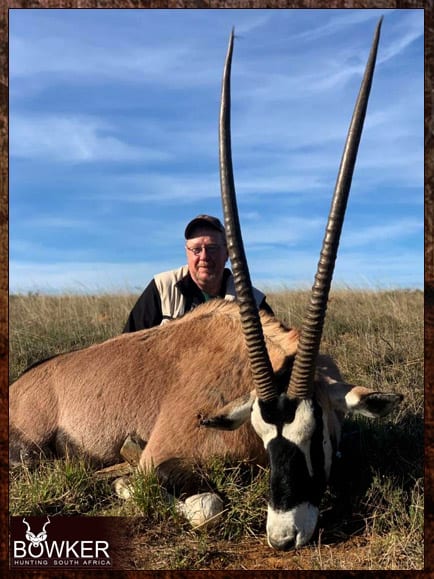
Widely hunted safari style for its spectacular horns that average 33 inches in length.
They use their horns to defend themselves and their young from predators. The males use their horns to protect their territories from other males.
Unusually, gemsbok hunting is one of the few antelope species where female trophies are sometimes more desirable than male ones.
Gemsbok is light brownish-grey to tan in color, with lighter patches toward the rump’s bottom rear. Their tails are long and black.
A blackish stripe extends from the chin down the lower edge of the neck and through the juncture of the shoulder and leg along the lower flank of each side to the rear leg.
The Gemsbok has very muscular necks and shoulders, and their legs have white ‘socks’ with a black patch on both front legs.
The face is black with white marks, and the tail is long and black.
A rough coat with coarse hair, predominantly khaki.
Gemsbok stands about 47 inches at the shoulder. Male Gemsbok can weigh between 400 and 530 pounds, while females weigh 220 and 440 pounds.
Females isolate themselves from the herd before giving birth. After giving birth, a mother gemsbok hides her calf.

Information for Gemsbok Game hunts

This differs from most antelope species, whose young travel with the herd almost immediately.
The mother remains close to her concealed offspring and visits them daily for her calf to suckle.
New-born are colored in an inconspicuous brown, blending with their environment.
Their black and white face markings won’t appear until it is ready to join the mother’s herd. The calf will continue suckling until it is six to nine months old.
The social structure of the Gemsbok is different from most other antelope species.
Other antelope in the area, like blesbok, employ a harem system where one dominant breeding male controls a group of females and young. Bachelor males form separate herds or hold a particular area.
On the other hand, gemsbok form mixed herds of both males and females.
Sparring contests that may escalate into fights serve to maintain the hierarchy in the herds.
These fights will likely start due to competition for resources, such as females in estrus or drinking at a water hole.
Our packages include Gemsbok hunts and other trophies such as sable antelope, nyala, kudu, and the black wildebeest.
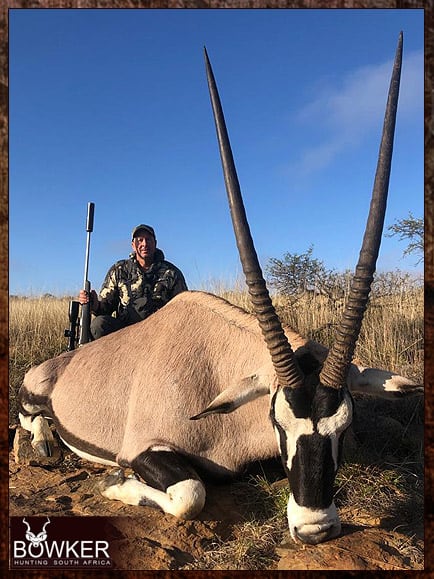
Frequently Asked Questions
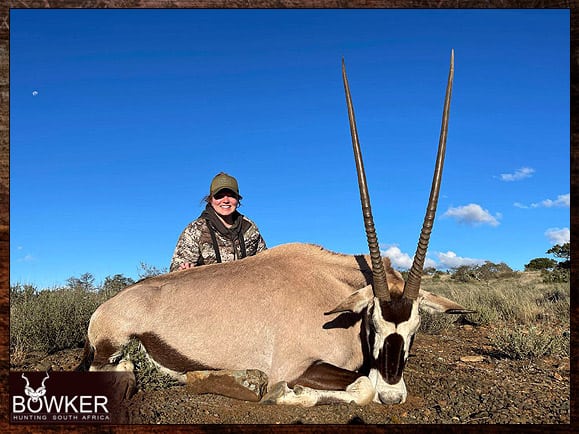
How much does it cost to hunt a Gemsbok?
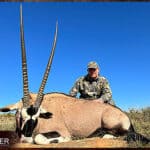
Trophy fee for a standalone Gemsbok hunt are between $1200 and $1800. Daily rates vary between $250 and $500 per day.
Included in the Gemsbok trophy fee is a licensed guide. As well as a hunting license and all permits.
A Gemsbok trophy is often included in a plains game package. Package prices vary from $3,000 – $10,000, depending on location and size. Packages include 5 – 7 trophy animals, accommodation, meals, and daily rates.
How to hunt Gemsbok?
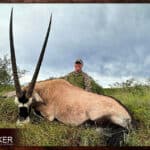
Gemsbok is hunted in a mixture of plains and bush. Hunts are conducted using ambush techniques in open country and walk and stalk methods where cover is available.
Where do you shoot a Gemsbok?
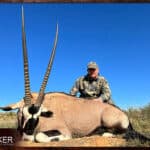
Shot placement must be in the bottom third of the animal directly above the front shoulder. This will ensure a heart or lung shot. Avoid head and neck shots, which are high-risk.
What is a trophy, Gemsbok?
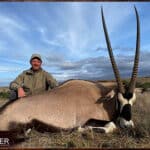
Gemsbok trophies have a Horn Length of approximately 36 – 38 inches. The minimum qualification score under Safari Club International for a Gemsbok is 81. Add the length of each horn and the circumference of the bases to get your SCI score.
Males and females make spectacular trophies. Females have longer horns.
How do you judge a Gemsbok trophy?
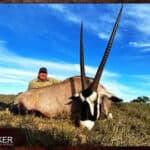
In assessing the trophy, remember that the cow’s horns are longer than the male’s and often out-score the bull. Remember that the body size differs remarkably from one Gemsbok to another.
Also, mature bulls will stand out in the herd and be more visible in horn length and shoulder height.

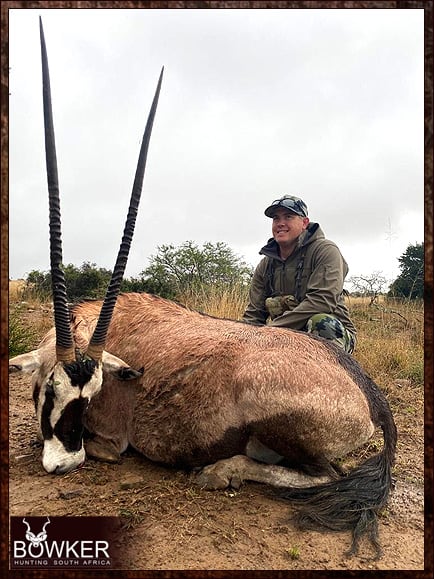
Seasonal Restrictions
When can you hunt Gemsbok in South Africa?
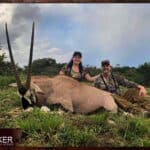
There are no seasonal restrictions on gemsbok hunting in the Eastern Cape of South Africa.
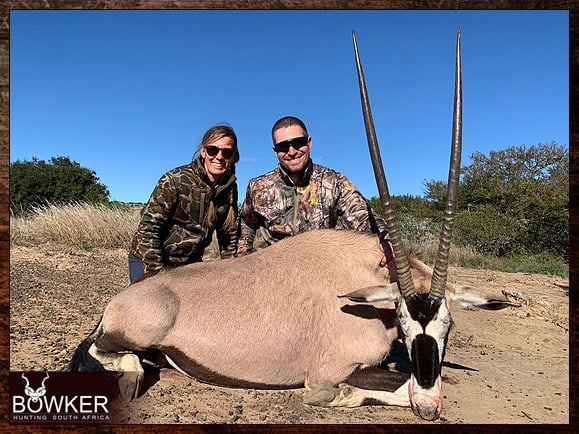
What Calibre is Recommended for Gemsbok Hunts?
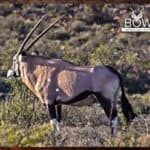
We recommend the flat shooting 300 Winchester or 7mm magnums with high-quality tactical scopes and a suppressor.
The Gemsbok in Pictures
